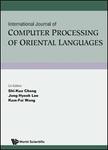版权所有:内蒙古大学图书馆 技术提供:维普资讯• 智图
内蒙古自治区呼和浩特市赛罕区大学西街235号 邮编: 010021

作者机构:Department of Computer Science and Engineering Electrical and Computer Engineering Division and Advanced Information Technology Research Center (AITrc) Pohang University of Science and Technology (POSTECH) San 31 Hyoja Dong Pohang 790-784 Korea Language Engineering Institute Department of Computer Electron and Telecommunication Engineering Yanbian University of Science and Technology (YUST) Yanji Jilin 133-000 P.R. China
出 版 物:《International Journal of Computer Processing of Languages》
年 卷 期:2005年第18卷第3期
页 面:227-242页
学科分类:08[工学] 0812[工学-计算机科学与技术(可授工学、理学学位)]
主 题:Modal expression Modality Modality system Chinese-Korean MT system Tense Aspect Mood Negation Voice
摘 要:To generate a proper Korean predicate, a natural modal expression is the most important factor for a machine translation (MT) system. Tense, aspect, mood, negation, and voice are the major constituents related to modal expression. The linguistic encoding of a modal expression is quite different between Chinese and Korean in terms of linguistic typology and genealogy. In this paper, a new applicable categorization of Korean modality system viz. tense, aspect, mood, negation, and voice, will be proposed through a contrastive analysis of Chinese and Korean from the viewpoint of a practical MT system. In order to precisely determine the modal expression, effective feature selection frameworks for Chinese are presented with a variety of machine learning methods. As a result, our proposed approach achieved an accuracy of 83.10%.